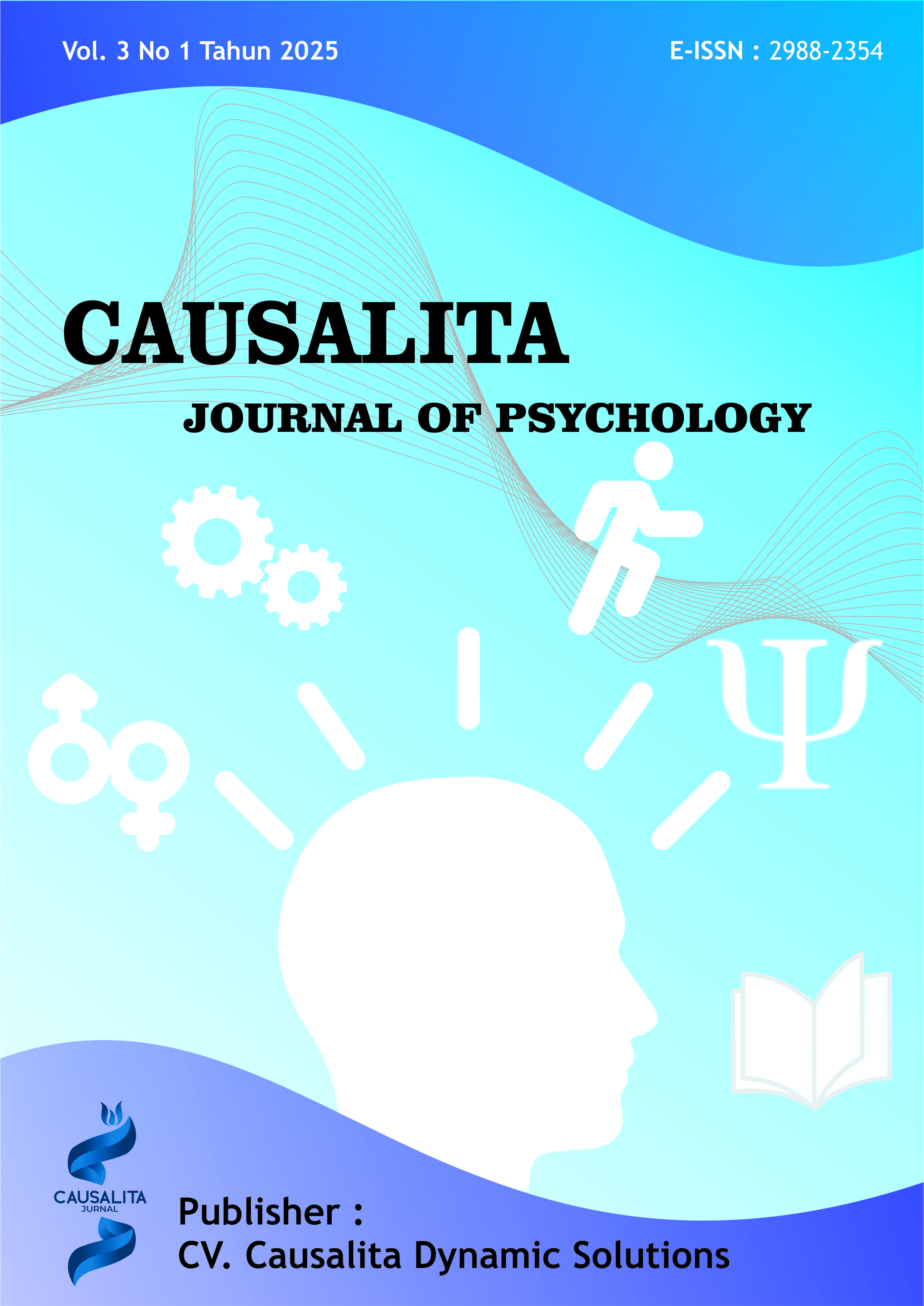An Overview of The Resilience of Inmates in The Padang Class IIB Women's Prison Reviewed by Demographic actors
DOI:
https://doi.org/10.62260/causalita.v3i1.404Keywords:
Inmates, Resilience, Demographic FactorsAbstract
A prisoner is defined as someone who has violated societal norms and received a legal decision resulting in the deprivation of their freedom, leading to the loss of personal independence. As a consequence, they serve their sentence in a correctional facility. Imprisonment can lead to various issues, such as inner conflict, irritability, anxiety, boredom due to routine activities in prison, longing for family, difficulty adapting, and unpreparedness in facing reality.Therefore, individuals in such conditions must develop resilience. Resilience refers to the ability to cope with and adapt to difficult situations or life challenges, including enduring pressure and overcoming suffering or trauma experienced throughout life.This study aims to explore resilience among inmates at Class IIB Padang Correctional Facility. The research employs a qualitative approach by distributing surveys using an open-ended questionnaire, divided into three stages: preparation, development, and implementation.The findings illustrate various factors contributing to resilience among inmates in the Class IIB Women's Correctional Facility in Padang. A total of 25 factors were identified, with the three most significant being family support, sentence duration, and acceptance (sincere acceptance of their situation). Additionally, the study highlights activities that help inmates maintain resilience, including sports, religious practices, and artistic activities.The study also indicates that demographic factors such as age, education level, length of sentence, and occupation influence inmates' resilience.
References
Almeida, D. M. (2005). Resilience and vulnerability to daily stressors assessed via diary methods. Current Directions in Psychological Science, 14(2), 64–68. https://doi.org/10.1111/j.0963-7214.2005.00336.x1h
Anggraini, D., Hadiati, T., & S, W. S. A. (2019). Perbedaan Tingkat Stres Dan Tingkat Resiliensi Narapidana Yang Baru Masuk Dengan Narapidana Yang Akan Segera Bebas (Studi Pada Narapidana Di Lembaga Pemasyarakatan Klas Iia Wanita Semarang). Diponegoro Medical Journal (Jurnal Kedokteran Diponegoro), 8(1), 148–160.
Anggraini, & Erlina. (2015). WANITA DALAM MASA PEMBINAAN Studi Kasus : Lembaga Pemasyarakatan Wanita Klas II A Bulu Semarang. 26, 284–311.
Aulia, S., Alfatika, Z. A., Hikmawati, N., Pamulasih, W., Farrasadani, H. A., & Harisuci, T. C. (2023). STUDI FENOMENOLOGI: RESILIENSI NARAPIDANA WANITA YANG MEMPUNYAI BALITA. Psikofusi: Jurnal Psikologi Integratif, 5(4), 12–18.
Azani. (2013). GAMBARAN PSYCHOLOGICAL WELL-BEING MANTAN NARAPIDANA. https://api.semanticscholar.org/CorpusID:149091231
Boeree, C. G. (2010). Personality theories: Melacak kepribadian anda bersama psikolog dunia (Edisi Baru). Ar-Ruzz Media.
Devi, R. R. P. (2015). RESILIENSI NARAPIDANA DEWASA DI LEMBAGA PEMASYARAKATAN KLAS IIA SRAGEN. Skripsi, 13.
Doni, M. Y. D. E., & Naben, M. A. (2023). RESILIENSI NARAPIDANA RUMAH TAHANAN KELAS IIB MAUMERE Studi Deskriptif Significant Adversity Pada Narapidana. 6, 40–52.
Farial, Handayani, E. S., & Tohari, S. (2020). Studi Perbandingan Tingkat Resiliensi Pengguna Narkoba Ditinjau Berdasarkan Tingkat Usia. Jurnal Consulenza: Jurnal Bimbingan Konseling Dan Psikologi, 3(1), 30–39.
Gąsior, K. (2018). The links between posttraumatic stress, attachment patterns and quality of life in incarcerated and addicted women. The role of resilience. Psychiatria Polska, 52(6), 1113–1125. https://doi.org/10.12740/PP/OnlineFirst/76823
Grotberg, E. H. (1995). A guide to promoting resilience in children: Strengthening the human spirit (Vol. 8). Bernard van leer foundation The Hague, Netherlands.
Hurlock, E. B. (2002). Psikologi Perkembangan (5th ed.). Erlangga.
Jannah, N. (2018). Hubungan antara hardiness dengan resiliensi pada narapidana di lembaga pemasyarakatan klas II A perempuan malang. Skripsi. Fakultas Psikologi. Universitas Muhammadiyah Malang: Malang.
Mariana, R., & Sagita, M. P. (2019). STRATEGI REGULASI EMOSI NARAPIDANA ANAK DI LEMBAGA PEMBINAAN KHUSUS ANAK (LPKA) KLAS II TANJUNG PATI PAYAKUMBUH. 12(1), 10–12.
Mayangsari, M. W., & Suparmi. (2020). Resiliensi pada Narapidana Tindak Pidana Narkotika Ditinjau dari Kekuatan Emosional dan Faktor Demografi. Gadjah Mada Journal of Psychology (GamaJoP), 6(1), 80. https://doi.org/10.22146/gamajop.52137
PRABOWO, M. A. (2020). Peran dukungan keluarga terhadap resiliensi akademik siswa SMA broken home di kota Palembang. Universitas Sriwijaya.
Raisa, A. E. (2016). Hubungan Antara Dukungan Sosial dengan Resiliensi pada Narapidana di Lembaga Pemasyarakatan Kelas IIA Wanita Semarang. Jurnal Empati, 5(3), 537–542.
Reivich, K., & Shatté, A. (2002). The resilience factor: 7 essential skills for overcoming life’s inevitable obstacles. Broadway books.
Riza, M., & Herdiana, I. (2012). Resiliensi pada narapidana laki-laki di Lapas Klas 1 Medaeng. Jurnal Psikologi Kepribadian Dan Sosial, 1(03), 142–147.
Rizkina, S. (2018). Pengaruh dukungan sosial dan harapan terhadap resiliensi anak didik LAPAS kelas IIA Salemba. Jurnal Raudhah, 06(02), 1–15. http://jurnaltarbiyah.uinsu.ac.id/index.php/raudhah
Sarafino, E. P., & Smith, T. W. (2014). Health psychology: Biopsychosocial interactions. John Wiley & Sons.
Sari, U. H. K., Purnawan, I., & Hidayat, A. I. (2022). Hubungan Kecerdasan Emosional Dengan Resiliensi Pada Wanita Pasca Bencana Banjir. Dunia Keperawatan: Jurnal Keperawatan Dan Kesehatan, 9(3), 342. https://doi.org/10.20527/dk.v9i3.9731
Sholichatun, Y. (2011). Stres dan Staretegi Coping pada Anak Didik di Lembaga Pemasyarakatan Anak. 8(1), 23–42.
Sugiyono. (2019). Metode Penelitian Kuantitatif Kualitatif Dan R&D.
Sukma, F. M., & Panjaitan, R. U. (2019). Dukungan Sosial Dan Hubungannya Dengan Tingkat Depresi Pada Narapidana Anak. Jurnal Keperawatan Jiwa, 6(2), 83. https://doi.org/10.26714/jkj.6.2.2018.83-90
Zainuri, I., Azizah, L. M., Mustikasari, M., & Aprilia, N. (2022). Hubungan Lama Masa Hukuman Dengan Tingkat Stres Pada Narapidana Di Lembaga Pemasyarakatan Klas Ii B Kota Mojokerto. NURSE: Journal of Nursing and Health Science, 1(1), 34–42. https://doi.org/10.15408/nurse.v1i1.25507
Downloads
Published
Issue
Section
License
Copyright (c) 2025 Donna Aryati, Devi Ruslin

This work is licensed under a Creative Commons Attribution-ShareAlike 4.0 International License.






